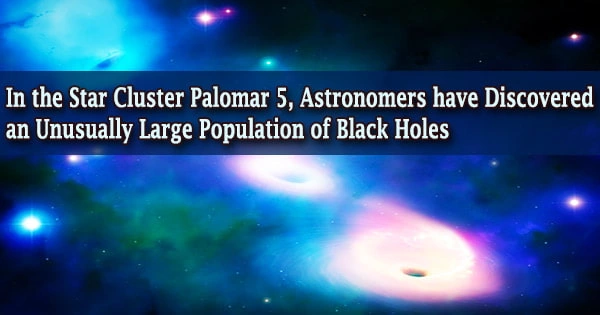Palomar 5 is a one-of-a-kind cluster. This is due to the fact that it is one of the “fluffiest” clusters in our Galaxy’s halo, with an average gap between stars of a few light-years, about equivalent to the distance between the Sun and the closest star. Second, it is connected with a specular stellar stream that covers greater than 20 degrees across the sky.
The mutual gravitational attraction of its components, which are physically tied by shared origin, holds a star cluster together. During the twentieth century, enormous reflectors and other more specialized devices, like as Schmidt telescopes, were used to expand cluster identification to more distant galaxies.
An international team of astronomers and astrophysicists led by the University of Barcelona show in a paper published today (July 5, 2021) in Nature Astronomy that both of Palomar 5’s distinguishing features are likely the result of an oversized black hole population of more than 100 black holes in the cluster’s center.

We do not know how these streams form, but one idea is that they are disrupted star clusters. We can’t be sure because none of the freshly identified streams have a star cluster linked with them. To learn more about how these streams form, we need to look at one that has a star system attached to it. Palomar 5 is the only case, making it a Rosetta Stone for understanding stream formation and that is why we studied it in detail.
Prof Mark Gieles
“The number of black holes is roughly three times larger than expected from the number of stars in the cluster, and it means that more than 20% of the total cluster mass is made up of black holes. They each have a mass of about 20 times the mass of the Sun, and they formed in supernova explosions at the end of the lives of massive stars when the cluster was still very young,” says Prof Mark Gieles, from the Institute of Cosmos Sciences of the University of Barcelona (ICCUB) and lead author of the paper.
Einstein’s theory of general relativity, which proved that when a large star dies, it leaves behind a tiny, dense remnant core, is most renowned for predicting black holes. The equations demonstrated that if the core’s mass is more than three times that of the Sun, gravity will override all other forces, resulting in a black hole.
Tidal streams are streams of stars released from star clusters or dwarf galaxies that have been disrupted. Nearly thirty thin streams have been identified in the Milky Way halo in the last several years.
“We do not know how these streams form, but one idea is that they are disrupted star clusters. We can’t be sure because none of the freshly identified streams have a star cluster linked with them. To learn more about how these streams form, we need to look at one that has a star system attached to it. Palomar 5 is the only case, making it a Rosetta Stone for understanding stream formation and that is why we studied it in detail,” explains Gieles.
From the creation of the cluster through its eventual disintegration, the authors model the orbits and history of each star. They tweaked the cluster’s initial parameters until they discovered a satisfactory match between the stream’s observations and the cluster. Palomar 5 was discovered to have a smaller black hole fraction than other galaxies, but stars fled more effectively than black holes, therefore the black hole fraction progressively grew.
In gravitational slingshot interactions with stars, the black holes actively inflated up the cluster, resulting in, even more, escape stars and the creation of the stream. The cluster will be fully made up of black holes just before it totally dissipates in around a billion years.
“This work has helped us understand that even though the fluffy Palomar 5 cluster has the brightest and longest tails of any cluster in the Milky Way, it is not unique. Instead, we believe that many similarly puffed up, black hole-dominated clusters have already disintegrated in the Milky Way tides to form the recently discovered thin stellar streams,” says co-author Dr. Denis Erkal at the University of Surrey.
Gieles points out that in this paper “we have shown that the presence of a large black hole population may have been common in all the clusters that formed the streams. This is important for our understanding of globular cluster formation, the initial masses of stars, and the evolution of massive stars. This work also has important implications for gravitational waves.”
“A substantial percentage of binary black hole mergers are thought to occur in star clusters. The number of black holes in clusters is significant uncertainty in this scenario, which is difficult to restrict observationally because we can’t detect black holes. Our method gives us a way to learn how many BHs there are in a star cluster by looking at the stars they eject,” says Dr. Fabio Antonini from Cardiff University, a co-author of the paper.
Walter Baade found Palomar 5 as a globular cluster in 1950. It is one of the about 150 globular clusters that revolve around the Milky Way, and it is located in the Serpens constellation at a distance of around 80,000 light-years.
It, like most other globular clusters, is older than 10 billion years, indicating that it originated during the early stages of galaxy formation. It’s roughly 10 times less massive and 5 times longer than a typical globular cluster, and it’s nearing the conclusion of its life cycle.
















